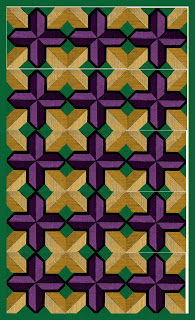I can't quilt. I am practicing on the simplest of Civil War quilt patterns the one that is used for Sanitary Commission "comforts." You can see that simple pattern at The Home of the Brave Quilt Project. The Sanitary Commission was a group of Civilians during the Civil War who worked together to bring sanitary conditions to union camps. They also held fundraisers and made supplies to send to the Union Army. Of these supplies they sent thousands of quilts. They tended to use simple quilt patterns because quantity and functionality was more important than beauty.
My attempts with that simple pattern have left me with uneven quilt pieces, pieces that don't line up and fabric that frays until it is nonexistent. That being said, if I could quilt, I would make this pretty quilt pattern from 1855.
It will never happen as the pattern calls for silk and the black cross outlines are made from velvet sewn on top of the finished quilt. How pretty would that be? I don't think I've ever seen a silk quilt, but I imagine it would be very smooth to the touch and the velvet would be soft.I also like the colors that the pattern calls for, they really weren't afraid of contrasting color, were they? I have always really loved quilts but I just don't have the ability to piece all those pieces together properly. But for those you who can quilt and would enjoy sleeping under a piece of art, this pattern would be lovely and I would love to see the finished product.
***The Home of the Brave quilt project is actually really interesting. The organization collects quilts made by civilians and sends them to families who have had a loved one die in combat. It is a cool project to be involved with if you can quilt.***
My attempts with that simple pattern have left me with uneven quilt pieces, pieces that don't line up and fabric that frays until it is nonexistent. That being said, if I could quilt, I would make this pretty quilt pattern from 1855.
It will never happen as the pattern calls for silk and the black cross outlines are made from velvet sewn on top of the finished quilt. How pretty would that be? I don't think I've ever seen a silk quilt, but I imagine it would be very smooth to the touch and the velvet would be soft.I also like the colors that the pattern calls for, they really weren't afraid of contrasting color, were they? I have always really loved quilts but I just don't have the ability to piece all those pieces together properly. But for those you who can quilt and would enjoy sleeping under a piece of art, this pattern would be lovely and I would love to see the finished product.
***The Home of the Brave quilt project is actually really interesting. The organization collects quilts made by civilians and sends them to families who have had a loved one die in combat. It is a cool project to be involved with if you can quilt.***













